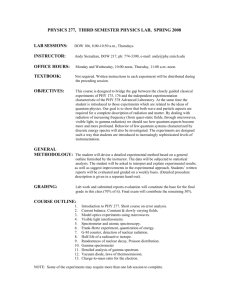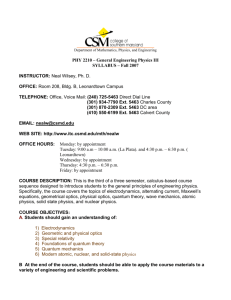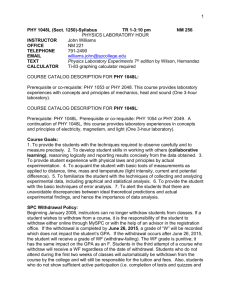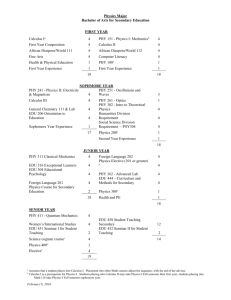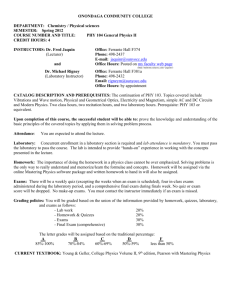PHY222 - University of South Alabama
advertisement
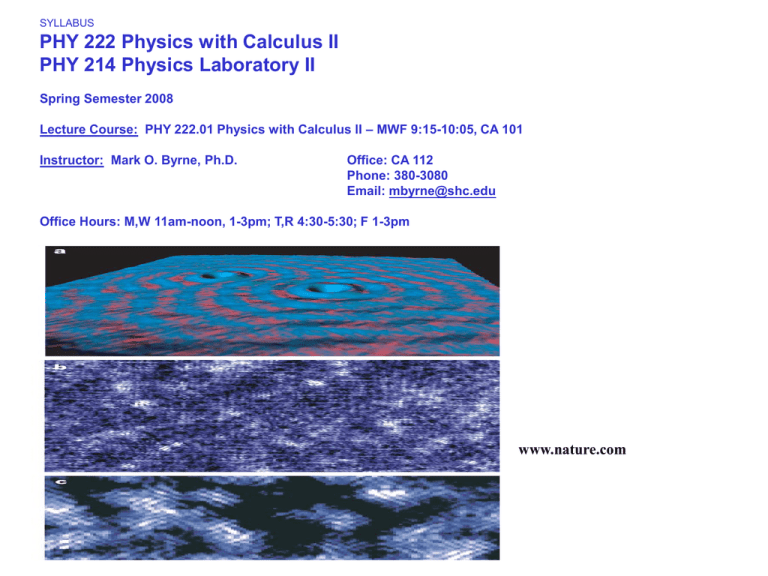
SYLLABUS PHY 222 Physics with Calculus II PHY 214 Physics Laboratory II Spring Semester 2008 Lecture Course: PHY 222.01 Physics with Calculus II – MWF 9:15-10:05, CA 101 Instructor: Mark O. Byrne, Ph.D. Office: CA 112 Phone: 380-3080 Email: mbyrne@shc.edu Office Hours: M,W 11am-noon, 1-3pm; T,R 4:30-5:30; F 1-3pm www.nature.com Laboratory Course: (Instructor Dr. Byrne) PHY214.01 Physics Laboratory I, T 1:30-4:30, CA 102 PHY214.02 Physics Laboratory I, R 1:30-4:30, CA 102 PHY 222 (Lecture) and PHY 214 (Laboratory) are to be taken concurrently. They are corequisites of one another. Students will receive a grade in each course, which are independent of each other. Course Goals: The mission of Spring Hill College states, “…we strive to awaken mind and spirit to the pursuit of truth and an ever-deepening appreciation of the beauty of creation.” One means of appreciating such beauty is by carefully studying the physical universe. As the first paragraph of our text states, “The beauty of physics lies in the simplicity of its fundamental theories and in the manner in which just a small number of basic concepts, equations, and assumptions can alter and expand our view of the world around us.” Physics is an experimental science based on controlled observations and the synthesis of these observations into well-defined, self-consistent mathematical constructions (theories) consistent with all observations. Physics involves the quantitative analysis of physical interactions of matter on widely varying length and time scales, from small to huge numbers of interacting constituents (electrons, atoms, molecules, galaxies, etc.). A fundamental goal of physics is to provide a quantitative understanding of the elementary rules at work in our universe. The primary goal of the physics sequence is to give the student a unified view of physics. This is accomplished by studying the basic principles of classical physics, their mathematical representations, experimental methods of verification, and their limitations. Emphasis of the lecture component is placed on understanding and applying the basic principles of physics in the form of problem solving. Course Description: PHY 222 and PHY 214 are organized around a basic principle – Education for the common good of the global community. PHY 222 and PHY 214 are the second of a two-semester sequence in Physics. The course covers wave motion, classical electromagnetic theory, and optics. In wave motion the course will include material on mechanical waves, superposition, and standing waves. In electromagnetic theory the content includes Coulomb’s Law, electric fields, electric potentials, Gauss’ Law, Ampere’s Law, Faraday’s Law and electromagnetic waves. In optics the course includes material on geometric optics (including reflection, refraction, mirrors, and lenses) and physical optics, including interference and diffraction. Course Objectives: After completion of PHY 222 and the accompanying laboratory PHY 214 students will be able to - demonstrate a clear understanding of wave motion, electromagnetic theory and optics, - demonstrate problem-solving skills, - demonstrate the proper use of scientific words, both in writing and orally, - demonstrate skills in measuring physical quantities, - demonstrate the ability to record, interpret, and express the results of laboratory experiments in a clear and concise laboratory report, - demonstrate the ability to use the following computer programs: Fit Kit, Math Cad, Precision Timer, Data Monitor and Power Amplifier. Course Administration: Lecture Component Prerequisite: PHY 221 Corequisite: PHY 214 1. Text: Principles of Physics (4th ed.) by Serway and Jewett, Saunders College Publishing 2. Evaluation (a) Exams There will be three 60 minute examinations during the semester counting 100 points each (300 points total, 50% of final grade). (b) Final Exam The final exam will be a comprehensive examination counting 200 points (33.33% of final grade). You must obtain a minimum grade of 50% on the final exam to receive a passing grade in PHY 222. (c) Homework and Quizzes There will typically be a quiz once a week when exams are not scheduled. Homework for each chapter must be turned in for completion credit. All the quizzes and homework throughout the semester will sum to 100 points (16.77% of final grade). The quizzes are from the assigned homework problems and are intended as a guide to help you stay up to speed with the course, correct any misconceptions that may be present from the previous lecture, and to prepare for the exams. (d) Final Grade (average) = 1/6 (Exam 1 + Exam 2 + Exam 3 + Final Exam + Quiz/HW Average) Grade Scale (%): A = 90-100, B = 80-89, C = 70-79, D = 60-69, F = 0-59. + and – grades are given as appropriate as determined by the instructor. (e) Make-up Exam Policy: Exams are given only when scheduled. No make up exams and/or quizzes will be given. 4. Homework: Questions and problems will be assigned for each chapter. A listing of the assigned questions and problems is attached. 5. Attendance Policy: Attendance is expected at every class. WP/WFs are given rarely and only at the discretion of the instructor. 6. Policy Statement on Students with Disabilities: Students who wish to receive disabilities accommodations should contact Mrs. Dunklin, Coordinator for Student Support Services at 380-3470 as soon as possible so that warranted accommodations can be arranged. Her office is located in Student Academic Services, 1st Floor, Administration Building. PHY 222 Course Schedule - Spring 2008 Instructor: Mark O. Byrne, Ph.D. Week Month 1 2 3 4 Jan 5 Feb 6 7 8 9 March Dates Chapter(s) 9,11 14,16,18 23,25 28, 30, Feb 1 8-Feb 11,13,15 18,20,22 25,27,29 3,7 13,14 14,16 16 April 14,16,18 21,25 28,30 19 20 21 Electric Forces and Electric Fields Electric Potential and Capacitance Current and DC circuits DC circuits (cont’d)/Magnetic Forces and Fields 22 23 Magnetic Forces and Fields Faraday's Law and Inductance Spring Break Faraday's Law (cont'd), Electromagnetic Waves Electromagnetic Waves (cont'd)/Reflection and Refraction Exam # 2 21,24,26,28 31, Apr 2,4 7,9 Mechanical Waves Mechanical Waves (cont'd)/ Superposition and Standing Waves Superposition and Standing Waves (cont’d)/ Kinetic Theory of Gases Kinetic Theory of Gases (cont’d) Exam # 1 10,12,14 17,19 11-Apr 15 16 17 13 21,22 5-Mar 10 11 12 13 14 Topics 23,24 24,25 Exam # 3 25,26 26,27 27,28 Reflection and Refraction (cont'd), Geometric Optics Geometric Optics/Wave Optics Wave Optics/Quantum Physics Dates of Interest: Jan 21 (MLK), Feb 4-6 (Mardi Gras), March 21-28 (Spring Break); Apr 23 (COOL Day) Final Exam: Friday, May 2nd, 8:00-10:00am Note: The Final Exam will be a comprehensive exam. PHY 222 Homework Spring 2008 Check yourself - reading each assigned chapter, answering the quick quizzes in the text, and practicing with the worked Examples will help you master the course material. Quiz questions are selected from the homework conceptual questions and problems listed below for which the material has been discussed in lecture. Conceptual Chapter Questions Problems 13 1,2,5,7-11,16 1,3,7,13,14,19,35,37,48 14 1,3,5-7,12 1,5,10,17,23,27,31,34,39 16 4,6,7,11,13,18 5,14,17,21,31,32,35,36,39 19 1,5-7,11,13-15 2,4,5,8,13,21,31,35,37,50,54 20 1,2,5, 6,11,16 2,3,5,9,13,21,27,33,39,41,50 21 1,2,5,7-11,13,16-18,21 1-3,6,7,13,23,27,31,35,41 22 1,3,4,7,9,11-16 1,3,6,9,15,21,26,31,35,37,57 23 1-3,4,5,7,9,14-16 1,3,5,13,20,21,25,29,35 24 2-4,8,9,11,13,16-18 1,7,13,14,23,26,39,41,55 25 1,4,5,,8,9,11,16 3,7,12,15,17,31,35,41 26 1-3,5,6,10,12,18 3,7,9,21,23,31,44,49 27 1-4,6-8,11-13 1,3,5,11,14,17,20,21,27,33 Text: Principles of Physics, A Calculus-Based Text, 4th Ed., Serway and Jewett Course Administration: Laboratory Component – PHY 214 Corequisite: PHY 222 The laboratory is designed to complement the lecture, PHY 222. However, they are independent courses. Course Objectives: To provide hands-on experience in recording and interpreting data and to promote an appreciation for scientific experimental methods. Content: The following 11 experiments will be performed during the semester not necessarily in the order listed. A written lab report will be submitted at the end of each laboratory period. Experiment Number in Lab Manual Experimental Title 12 13 14 15 16 17 19 18 20 21 22 Waves on a String Speed of Sound The Electric Field: Mapping Electric Potential Magnetic Force on a Current-Carrying Conductor Ohm’s Law Resistors in Series and Parallel Mass of an Atom RC Circuits The Convergent Thin Lens and Spherical Mirror Diffraction Grating Charge to Mass Ratio of an Electron Each student is required to maintain a data book. The data book entries for each experiment should include: - - Experiment # and Title Date of Experiment Partner’s Name (if applicable) Purpose/objective of the experiment Data: Record all data directly in your data book. If there are any errors made, do not erase what you have entered, but cross it out neatly. Record data in tabular form, if possible. Calculations and Results: Record results in tabular form if possible. Analysis of Data and Conclusions: Each student should write their data analysis and conclusions independent of their lab partner. Students will be expected to convey their knowledge in a clear, concise manner using standard English. given if more than two laboratories are missed. A 10-point grading scale will be used. + and – grades may be given as appropriate. Attendance Policy: There are no excused absences. Each student is required to be present for each laboratory. WP/WFs are given rarely and only at the discretion of the instructor. Make-up Policy: If the student missed a laboratory assignment because of some serious reason, it is the student’s responsibility to arrange with the laboratory instructor a make-up period at the convenience of the instructor. Withdrawl from Lecture: PHY 214 is to accompany PHY 223. If a student withdraws from PHY 222 (lecture), the student is also required to withdraw from PHY 214 laboratory. Schedule (Subject to variation at the discretion of instructor) PHY 214 Lab Schedule Individual sections meet on either T or R, 1:30-4:30 Week 1 NO LAB 1st Week of Classes 2 Lab # 12 Jan 15,17 3 Lab # 13 Jan 22,24 4 Lab # 14 Jan 29,31 5 NO LAB Mardi Gras, Lecture Exam #1 Week 6 Lab # 15 Feb 12,14 7 Lab # 16 Feb 19,21 8 Lab # 17 Feb 26,28 9 NO LAB Lecture Exam #2 Week 10 Lab # 19 Mar 11,13 11 Lab # 20 Mar 18,20 12 NO LAB Spring Break Week 13 Lab # 21 Apr 1,3 14 NO LAB Lecture Exam #3 Week 15 Lab # 22 Apr 15,17 16 Lab # 23 Apr 22.24 17 NO LAB Last Week of Classes, Final Exam Chapter 13 Mechanical Waves - Propagation of a Disturbance - The Wave Model - The Traveling Wave - The Speed of Transverse Waves on a String - Reflection and Transmission of Waves - Rate of Energy Transfer by Sinusoidal Waves on Strings - Sound Waves - Doppler Effect http://science.hq.nasa.gov/kids/imagers/ems/wavesBreak.jpg Wave Pulses Exp (-x2)


